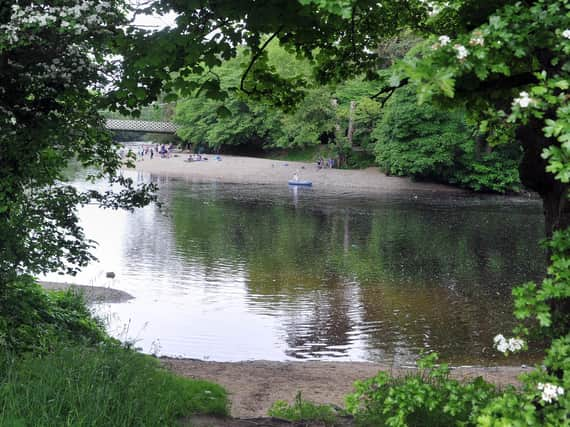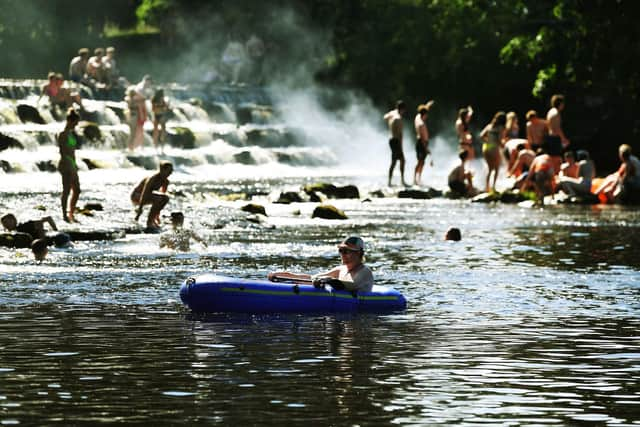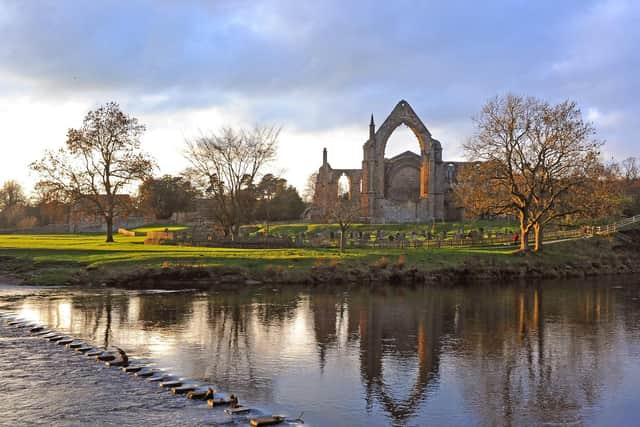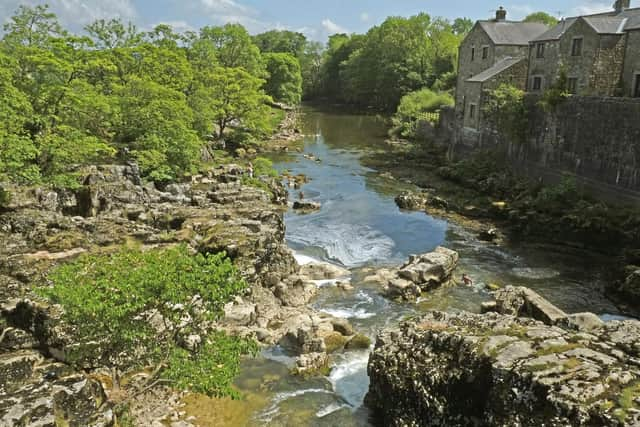This is why the River Wharfe is far more dangerous than most people think


In summer, thousands of daytrippers flock to its banks and swim in the water at popular spots such as Ilkley, Addingham, Burnsall and Burley.
Yet the death of an 18-year-old man from Bradford who drowned at Linton Falls last Friday - the hottest day of the year - is a stark reminder that the benign-looking Wharfe has claimed many lives. On the same day, two young women rescued a small boy who had been swept downstream at Burnsall from the water.
Advertisement
Hide AdAdvertisement
Hide AdMisleading depths, hidden drops and deceptively strong currents all combine to make certain stretches of the river treacherous to swimmers - many of whom are only children.


The water is also extremely cold, and its temperature rarely rises any higher during summer than it does in the winter. Many of those who get into difficulty while swimming do so because their bodies go into shock and they cannot reach the bank.
The Wharfe is so hazardous that Grassington-based public safety officer Lucy Osborn - a trained firefighter who works as a liaison point between all three emergency services - recommends that visitors avoid swimming in it altogether.
She admits that the large numbers of families visiting the Dales for the first time during lockdown - many of whom were not familiar with the river - made a tragedy like last Friday's almost inevitable.
Advertisement
Hide AdAdvertisement
Hide AdPSO Osborn was also at duty at Threshfield Quarry during the May heatwaves, when thousands of youths from all over the north turned up to party at the disused quarry's blue lagoon, which has since been drained. She believes it was 'sheer luck' that none of the revellers - who were under the influence of alcohol and drugs - died while 'tombstoning' from the sides of the former limestone pit.


"The main danger is cold water shock - it's something people just don't think about. It is what causes most of the fatalities, and it doesn't matter if you are a strong swimmer. There is not much you can do if your body goes into shock.
"With rivers like the Wharfe, you can't always see the bottom, and there are undercurrents - you're jumping into the unknown.
"During lockdown, we've had a lot of visitors from much further afield who had never been into the countryside before. They don't know the area, and they don't understand the precautions you need to take around open water swimming.
"It's not like jumping into a swimming pool."
Advertisement
Hide AdAdvertisement
Hide Ad

The emergency services are now expecting an influx of more first-time visitors over the remaining summer weekends, as they believe many previously 'undiscovered' places in the Dales are now much more widely known among city-dwelling families.
"We were really worried about a drowning happening, and I can see it happening again.
"The Wharfe is a big, fast-flowing river and it's unpredictable. We've had a lot of rainfall this week and the water level shoots up really quickly - this weekend the risks will be heightened.
"Often people are told by their friend about a shallow stretch ideal for swimming, then when they turn up a week later the level is a foot higher."
Advertisement
Hide AdAdvertisement
Hide AdPolice officers and the fire service will visit popular areas of the Wharfe this weekend to engage with swimmers, and they are also working with the National Park Authority to educate more people about the dangers of the river.
"It's not just about water safety. We have also had issues with littering and parking, and the general Countryside Code - things like knowing you need to close the gates and take your litter home with you because there aren't many bins here."
PSO Osborn was also first on the scene of a cow trampling last week, when a couple in their 50s visiting from County Durham were attacked by cattle because they picked up their dog rather than allow it to run away. They escaped with minor injuries, but the incident highlighted tourists' naivety about their conduct in the countryside.
"There is a different set of rules here and a lot of people just aren't aware. We are trying to get the message out. It has been creating a bit of ill feeling locally; we need people to visit, but we also need them to behave in the right way."
Advertisement
Hide AdAdvertisement
Hide AdPSO Osborn believes there are no stretches of the Wharfe that are truly safe.
"At Bolton Abbey they have banned swimming. It's quite slow-flowing on the estate, but it doesn't matter - it's still not safe. If you're taking children, don't allow them to swim - stick to paddling. You don't know the river. Stick to the shore.
"The Wharfe is very wide in places and if you get stuck out in the middle, you are in trouble."
If you see someone struggling in the water, PSO Osborn recommends shouting at them to remain calm, and using rope or a branch to try and reach them - there are no throwlines or lifebelts along the river.
Advertisement
Hide AdAdvertisement
Hide Ad"Don't jump in after them, unless it's a child in a part where you can touch the bottom. We don't want scores of people jumping into deep water and suddenly having three casualties rather than one. Ring 999 - up here we have the fell rescue teams, who were first on the scene at Linton Falls and who have some excellent equipment.
"Never jump in after your dog - it'll be a better swimmer than you and it won't listen if you try and calm it down. Walk further down the bank to a shallower area and keep your eye on it."
The history of drownings in the Wharfe
In 2016, Daniel Kirk-Hall recounted the story of how he saved two children from drowning in the Wharfe while on a day out with his family at the Ilkley pebble beaches.
The 40-year-old was having a picnic with his own children when they spotted two boys around the age of eight or nine who had got into difficulty. Daniel swum out to them, and found that their father was also struggling in the water while trying to rescue them. He later said that the trench beneath the boys was much deeper than normal - and speculated that the floods of the previous Christmas could be to blame.
Advertisement
Hide AdAdvertisement
Hide AdNetherby Deep, near the village of Kearby and the Harewood estate, used to have a notorious reputation. In the 1930s, it became a popular holiday destination, and a caravan park was built on one of the natural beaches, called Kearby Sands.
Sand was even brought from Bridlington to create an artificial bay, and there were chalets and a pub. On busy days in the 1950s, the banks would be packed with hundreds of people, many of them from Leeds.
One day in 1963, eight-year-old twins Andrew and Stewart Nicholson drowned in the Wharfe while their parents sunbathed nearby. Their disappearance was sudden, and few people spotted them struggling. They had fallen into an underwater trench called Netherby Deep, a 30ft drop onto a sandbank with strong currents and whirlpools. Police divers found their bodies 25ft below the surface.
Eight more children were rescued in the 1963 summer season alone, but by the 1970s Kearby Sands' popularity had waned as the era of cheap foreign travel began, and nowadays the spot is overgrown and attracts few visitors.
Advertisement
Hide AdAdvertisement
Hide AdAnother of the most dangerous stretches is the Strid, near Bolton Abbey, which has a shocking fatality rate. The river narrows significantly here, and there are strong, funnelled currents and submerged caves and crevices that trap anyone who falls in. In 2010, eight-year-old Aaron Page, from Pontefract, drowned after he slipped from a rock. A passer-by grabbed hold of him but he was dragged beneath the surface.
The Strid even claimed the life of one of the people who loved its beauty most - the watercolour artist Arthur Reginald Smith, who fell in and drowned while on a trip to paint the river in 1934. He was 63 at the time and many people were baffled as to why he had ended up in the water, as they believed he was too old to have attempted to jump across it.
In 1998, honeymooning couple Barry and Lynne Collett, 29 and 25, were found dead in the river, although there were no witnesses who could explain why they had entered the Strid. On the day they had been walking in the area, the depth had risen by around 5ft in less than a minute due to heavy overnight rain.
Because it's only 6ft across, many people are tempted to leap across the banks at the Strid - a decision that can prove fatal if they slip or fall.
Advertisement
Hide AdAdvertisement
Hide AdIn 1997, the deaths of two children in the Wharfe at Sandy Beaches, near Arthington, ended in a court case. Two eight-year-old girls, Charlea Fox and Jasmine Neville, drowned while playing a 'Baywatch' game while the 41-year-old woman looking after them smoked cannabis and drank with two men. The stretch of river appears calm but has hollows scoured out of the bank and tight bends.
Charlea and Jasmine had been taken to the spot with their parents and a group of adults for a barbecue, but could not swim and did not have armbands. The rest of the group had returned to Leeds, leaving the girls in the company of the family friend, who later admitted wilful neglect. She avoided jail, as the judge felt the other adults should not have left her alone with the children.
In 2009, Guiseley teenager Joel Scott, 19, died after falling from Loop Scar, a 30ft rock beside the river in Burnsall. He and a friend had been jumping from the cliff into the water. He slipped while trying to climb back up the Scar and suffered fatal head injuries.
Comment Guidelines
National World encourages reader discussion on our stories. User feedback, insights and back-and-forth exchanges add a rich layer of context to reporting. Please review our Community Guidelines before commenting.